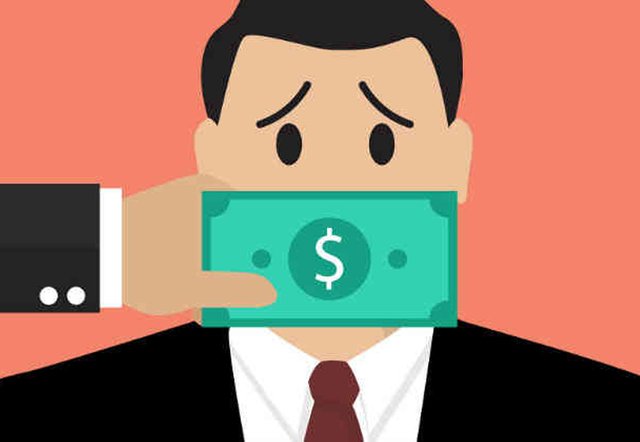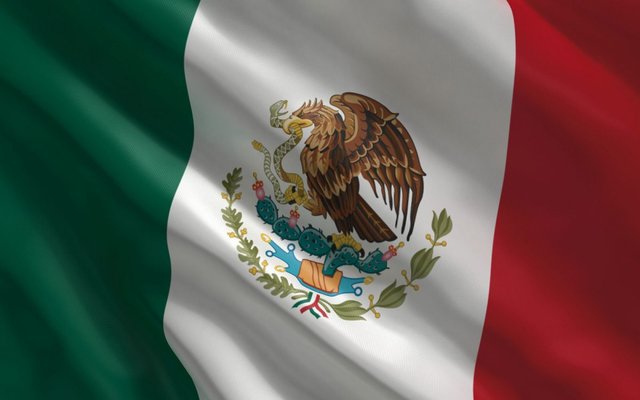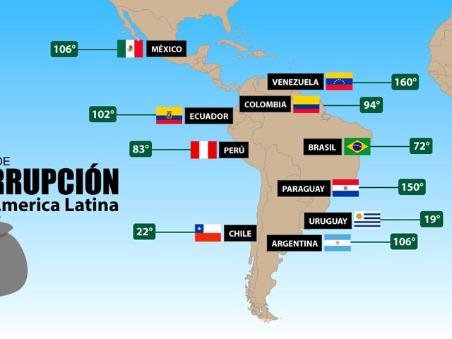
Political corruption refers to criminal acts committed by officials and public authorities who abuse their power and influence by intentionally misusing the financial and human resources they have access to, anticipating their personal interests and those of their relatives, to get an illegitimate advantage usually in a secret and private way. The term opposed to political corruption is transparency. According to Hernández Gómez (2018), corruption is defined as "any violation and / or act deviated, of any nature, for economic purposes or not, caused by the action or omission of institutional duties, who should seek the realization of the ends of the public administration and that instead prevents, delays or hinders them ". For this reason, one can speak of the level of corruption or transparency of a legitimate State.
The forms of corruption vary, but the most common are the illegitimate use of privileged information and sponsorship; in addition to bribes, influence peddling, extortion, fraud, embezzlement, prevarication, caciquismo, compadrazgo, cooptation, nepotism, impunity, and despotism. Corruption often facilitates other types of criminal acts such as drug trafficking, money laundering, and illegal prostitution, although, of course, it is not restricted to these organized crimes, and does not always support or protect other crimes.
Basics
Sayed and Bruce (1998) define corruption as "the misuse or abuse of public power for personal and private benefit", understanding that this phenomenon is not limited to public officials. It is also defined as the "set of attitudes and activities through which a person transgresses commitments acquired with himself, using the privileges granted, those agreements taken, with the aim of obtaining a benefit alien to the common good". Usually it is aimed at the governors or the elected or appointed officials, who are dedicated to take advantage of state resources to in some way enrich themselves or benefit relatives or friends.
The concept of corruption differs depending on the country or jurisdiction. The truth is that some political practices may be legal in one place and illegal in others. In some countries, police and prosecutors must maintain discretion over who they arrest and accuse, and the line between discretion and corruption can be difficult to draw. Countries in which the transparency of public accounts, acquisitions, concessions and the like are reduced or even non-existent will be more exposed to these actions, but if the media are not transparent when informing citizens or are restricted in the possibility to do it or simply manipulated, the corruption process will be more complicated to eradicate and judge.
Following Max Weber, it can be said that the great difference between the exercise of power by the Old Regime and the democratic world is that in the Old Regime this exercise was markedly patrimonial. However, in democratic regimes, when sovereignty falls back on the people, the exercise of power has to respond to the nation, and on the other hand the statements of Theobald, who, besides defining corruption as "illegal use, are useful. of the public office for personal benefit ", intuits that in the pre-industrial world personal dependencies gave way -in the industrial world- to the formal codification of social organizations seeking efficiency. However, family ties or friendship still persist with more presence as you descend into the bureaucratic pyramid. The developed countries also present corruption, but this tends to slow down when there are extraordinary increases in the quantity and quality of the means of production, and also if there is an international economy based on a stable system of exchange of values, goods and services. .
Types.
- The great corruption: that generates the distrust in the central authorities, perverts the operation of the state apparatus, and diverts resources.
-The small corruption: that tends to mobilize small amounts of economic resources or other goods, and that is located in the procedural stage of attention to the citizen.
Dynamic.
Ana María Arjona states that those authors who "study the phenomenon from the economic theory" approach corruption in a scenario of isolated cases of others, insufficient for the case of organized groups.
For his part Michael Johnston, 8 according to the processes experienced by corrupt actors, identifies four types of corruption: (A) market corruption (corrupt practices that occur in the exchange of goods and services); (B) patronage networks and machinery (routine practices that are in a few hands); (C) favoritism (provision of a small group of exceptional exchanges); (D) critical corruption (where there is a large number of people in extraordinary exchanges).
Causes.
-Among the many endogenous causes (those that have to do with the individual) we can list the following:
-Character of a social conscience.
-Lack of education or a culture of commitment.
- Distorted and negative paradigms.
- Antisocial personalities and megalomania.
- Biased perception of the degree of corruption present.
-Infravaluation of the possibility of being discovered.
-As exogenous elements of corruption (those that depend on society), we have:
Effective impunity in acts of corruption. - Partisan politics.
-Model models that convey a lack of values, making a lack of these.
-Excessive discretionary power of the public official.
-Concentration of powers and decision in certain government activities.
-Discretionality and lack of collegial decisions. - International bribery.
- Economic or legal control over the means of communication that prevent corruption cases from being exposed to the public.
-Salaries too low.
-Lack of transparency in the information concerning the use of public funds and decision processes.
-Poor efficiency of public administration.
-Extreme complexity of the system.
A classification of the causes of corruption gathered by Arjona from the contributions of authors such as Cagliani, Rose - Ackerman and Johnston identifies three types: economic, political - institutional and cultural
Effects
Economic effects

Corruption looks at economic development because it generates inefficiency and considerable distortions. In the private sector, corruption increases the cost of business and business activities since it is necessary to add the price of the illicit disbursements themselves, the cost of negotiating with public officials, and the risk of noncompliance with them. agreements or detection. Although some argue that corruption reduces costs by circumventing a possible excessive bureaucracy, the availability of bribes can also induce public officials to invent new rules and delays. Openly eliminating costly and lengthy regulations is better than covertly allowing them to be drawn using bribes. Where corruption inflates the cost of business, it also distorts the playing field, shielding companies with connections to competitors, thus sustaining inefficient companies.
Corruption also generates distortions in the public sector by diverting public investments to capital projects in which bribes and bribes are more abundant. Officials can increase the complexity of public sector projects to hide or pave the way for such deals, thus distorting investment even more. Corruption also lowers compliance with regulations related to construction, the environment or others, reduces the quality of government services and infrastructure and increases budgetary pressures on the government.
Economists argue that one of the factors behind the differences in economic development between Africa and Asia is that in the first, corruption has taken primarily the form of looting (in English: "rent extraction"), with the result that the financial capital obtained is moved out of the country, instead of being invested in it (hence the stereotyped image, often accurate, of African dictators having accounts in Swiss banks). In Nigeria, for example, more than 400 billion dollars were stolen from the treasury by Nigerian leaders between 1960 and 1999. Researchers at the University of Massachusetts have estimated that between 1970 and 1996, capital evasion from 30 sub-Saharan countries exceeded 187,000 million dollars, overcoming the external debts of those nations.The results, expressed in delays or halts of development have been modeled in theory by the economist Mancur Olson. In the case of Africa, one of the contributing factors to this behavior was the political instability, and the fact that the new governments frequently confiscated the assets obtained corruptly by the previous governments. This encouraged public officials to hide their wealth outside the country, far from the scope of possible future expropriations. In contrast, Asian managers, such as the "new order" of Suharto, frequently took a part of business transactions or provided conditions for development, through investments in infrastructure, law and order, etc.
Environmental and social effects.
Corruption facilitates environmental destruction. Corrupt countries can formally have legislation designed to protect the environment, but it can not be enforced if those responsible for it are easily bribed. The same can be applied for social rights, labor protection, unionization and the prevention of child labor. The violation of these legal rights allows corrupt countries to gain an illegitimate economic advantage in international markets.
Economist and Nobel Prize winner Amartya Sen has observed that "There is nothing that can be called an apolitical food problem". While drought and other natural events can trigger famine conditions, it is the government's action or inaction that determines its severity, and frequent, even if the famine will or will not occur. Governments with strong tendencies to kleptocracy can undermine food security, even when harvests are good. Public officials often steal property from the state. In Bihar, India, more than 80% of subsidiary food aid to the poor is stolen from corrupt public officials, and similarly, food aid is often stolen at gunpoint by rulers, criminals, warlords and the like. , and sold to obtain a benefit. The 20th century abounds in examples of governments that undermine the food security of their own nations, sometimes intentionally.
According to Transparency International's Corruption Perception Index 2011, "more than two thirds of the [183 countries and territories] classified scored below 5", where 0 is "extremely corrupt" and , «Very transparent». In 2009, the annual report said: "It is clear that no region of the world is exempt from the dangers of corruption."
Corruption can have disastrous consequences. Time magazine reported: "Corruption and negligence" were responsible - at least in part - for the very high number of deaths caused by the gigantic earthquake that struck Haiti in 2010. The magazine added: "To build buildings almost never resorted to to professional engineers; it simply bribes government inspectors. "
Political effects
Corruption produces distrust in political parties, in political leaders and in most public institutions. It leads many people to adopt less cooperative strategies and encourages desertion in order not to be exploited by people belonging to corrupt networks. As a consequence of the above, in many countries, it generates abstention and loss of interest in politics, for long periods. Of course, there are occasional protest movements that try to confront the political power, and generate political instability and subsequently political or police repression.
Effects on humanitarian aid.
The scale of humanitarian aid to the poor and unstable regions of the world is increasing, but it is very vulnerable to corruption, with food aid, construction and other valuable aid being the ones that are most at risk. Food aid can be diverted from its intended destination directly and physically, or indirectly through the manipulation of needs assessments, registration and distribution, to favor certain groups or individuals. In the same way, in the construction and reception there are numerous opportunities for diversion and benefit through inferior execution, bites or contracts and favoritism in the provision of adequate reception material. Therefore, although humanitarian aid agencies try to counteract the diversion of aid including an excess of aid, the recipients, for their part, are above all concerned about their exclusion. Access to aid may end up being limited to those with connections, those who pay bribes or who are forced to provide sexual favors. Similarly, those who are able to do this can manipulate the statistics to inflate the number of beneficiaries and transfer additional aid.
Corruption and human rights.

In broader terms, corruption is the appropriation of public power for private purposes. Going from the most general level to the most specific, corruption can be observed as: "the privatization of public power" 19 (the presentation of private interests as public, the state capture), the diversion of funds, the exchange relation between a public and private body to obtain an advantage.
There are indicators to measure corruption from the public perception. The best known measure is the Corruption Perceptions Index (CPI) conducted by Transparency International This indicator combines surveys and assessments on corruption collected by various consolidated institutions and that raise different questions from samples of several respondents, then they are standardized and Subject to statistical adjustments.
To understand the relationship between corruption and human rights, it is necessary to consider that States have 4 human rights obligations, the first one is "Respect" which implies not interfering with or endangering the satisfaction of human rights. This obligation is fulfilled by the State through abstentions and is violated through actions. The State must refrain from, for example, torturing or illegally depriving freedom. The second is "Protect", which falls to state agents according to their powers, to create the legal framework and institutional machinery necessary to prevent human rights violations committed by the state apparatus. The third is, "Guarantee", referring to maintain and ensure the enjoyment of human rights, likewise, will be responsible for improving them and restore them in case of violations, and the fourth "Promote" which means that state agencies have the obligation to provide people with all the necessary information to ensure that they are able to enjoy and exercise their human rights.
Corruption has negative effects on the exercise of human rights. This can be seen, in a first relationship, in which, through bribes, the authorities condition the exercise of human rights, for example, when prosecutors request money from victims of crime, when officials in court request bribes to the parties involved in any procedure, when nurses, doctors and hospital administrators request bribes from patients, etc. A second relationship occurs when the state accepts the payment of bribes so that an individual can perform an action prohibited by law, for example, contravene industrial safety measures that can lead to accidents, such as explosions in mines, obtain evaluations of impact through the payment of bribes to carry out megaprojects, such as dams, mines, wind farms and tourist developments; buy votes and bribe public officials in charge of organizing elections to commit electoral fraud; therefore, infringing the political rights of citizens as well as the other affected candidates.
A third relationship implies that acts of corruption generate a reduction of resources. If the budget is precarious, this leads to fewer goods and poor government services, a situation that is openly contrary to obligations for the protection, respect, guarantee and promotion of all rights. Corruption threatens the principle of progressivity and not regression. Corruption can decrease public funds through the improper use of funds, for example, for the private appropriation of public resources, the solicitation of bribes to buy goods or provide public services and the creation of surcharges and other types of additional costs that affect the quality of the process of acquisition of goods and services. 23 There is a fourth relationship that indicates that the structural corruption of the state causes the design processes of public policies to be distorted, generating a privatization of public resources, and with this, violations of human rights. that at the 11th International Anti-Corruption Conference it was pointed out that there is a conviction that all people have the basic human right to live in a society free of corruption.
The relationship between human rights and corruption is very close. Based on the empirical evidence obtained through various indicators that measure the perception of corruption, it has been identified that while there is greater corruption, the exercise of civil rights related to the empowerment of the person, such as freedom of expression, will be less religion, transit, entry and exit of the country, meeting and association and self-determination. In addition, it has been found that people who live in countries with a greater presence of corruption and violations of their human rights have living conditions totally different from those living in a country with less corruption.
Likewise, it has been recognized that the countries with greater corruption are more likely to qualify low in the exercise of women's economic and social rights. In this sense, the increase in impunity will mean that its interaction with corruption has a greater impact on human rights violations.
Other areas.
Corruption is not specific to poor or rich countries, developing countries or countries in transition. The preferred form of corruption varies from one country to another, and it is appreciated that in more transparent and democratic countries it adopts more subtle and complex forms, as there is greater public scrutiny. On the other hand, in countries without press, or free elections, corruption can take on grosser forms. In the countries of Western Europe there have been cases of bribery and other forms of corruption in all possible fields: for example, "under the table" disbursements made to surgeons reputed by patients with the intention of having their position in front of them. waiting lists, bribes paid by suppliers to the automotive industry to include low-quality connectors for example in safety equipment, such as airbags, bribes paid by defibrillator suppliers, (to sell low capacity electric capacitors), contributions paid by rich relatives to the "social and cultural fund" of a prestigious university in exchange for the acceptance of their children as students, paid bribes to obtain diplomas, financial and other advantages offered to the members of the executive committee of an automobile manufacturer in exchange for favorable positions to employees and votes, etc ... These varied manifestations of corruption In the last resort, they may pose a danger to public health or may produce discredit in certain essential institutions or social relationships.
Corruption can also affect the various components of sports activities (referees, players, medical and laboratory personnel involved in anti-doping controls, members of the national sports federation and international committees responsible for the decision on the status of contracts or competition venues).
There have also been legal proceedings against (members of) different types of non-profit organizations and NGOs, as well as religious organizations.
Ultimately, the distinction between public and private sector corruption sometimes seems somewhat artificial, and national anti-corruption initiatives may need to avoid legal and legal gaps in the coverage of the instruments.
Levels of corruption and transparency.
See also: Corruption Perception Index
One of the international organizations that monitors the level of corruption and transparency in 180 states of the world is Transparency International, based in Berlin, which presents an annual report of all countries and gives them a score of 1.0 to 10.0. According to the 2009 report, the country with the highest level of transparency in the world and ranked first with a score of 9.4 was Denmark and to date it remains in the number one position. On the other hand, the state with the lowest level of political transparency in the world and which occupied the 180th place was Somalia, with 1.1.
Factors that favor or hinder corruption.
Naturally there are many factors that affect the levels of corruption, some facilitating it and others making it difficult.
It is obvious that if at the institutional level and in the justice system there is a firm and attentive position regarding the different types of corruption, it will tend to decrease, and vice versa, if the opposite occurs. the sanction in relation to acts of corruption must exist and be strengthened more and more, but they also have their limits. Drug trafficking, for example, as well as certain corrupt sectors entrenched in politics, come to have so much power and to exert so much pressure that they hardly manage to be combated.
The key to to some extent curbing corruption may lie in the strengthening of the social-institutional fabric. In this sense, education in values can become one of the pillars, as well as less open and more transparent procedures in relation to money management and the implementation of financial transactions, including the use of so-called telematic money or digital money. , that is the use of electronic and nominative monetary species, without anonymous material base, and that allows the comfortable tracking of long chains of transactions.
Fight against corruption.
There are national and international entities, official and private, with the mission of supervising the level of international administrative corruption, as is the case of the United Nations (UN), the Organization of American States (OAS), and Transparency International . In addition, corruption is not only the responsibility of the official sector, the State or the government of the moment, but it especially includes the private sector, in which case we can talk about business corruption or influence peddling between the private sector and the public. . In many countries, such as those in Latin America, this sector has a large state influence and therefore the level of corruption present in those countries has a lot to do with the way in which the private sector behaves in conjunction with political systems .
The fight against corruption involves two complementary approaches: one focused on the fight against the acts carried out and another focused on preventive actions. Among the preventive actions can be named the transparency of the institutions before the use of public resources, greater independence of the media and the legal revision of the rules that relate to the judiciary to achieve greater independence of executive and legislative power . If the legislative and executive power are controlled by certain corrupt parties, they can modify the legislative situation by hindering judicial work or even turning it into something innocuous. In certain historical epochs, the appearance of manifestos, intellectual figures or new political parties provoke the necessary change in legislation so that acts of this nature do not happen.
Corruption by countries.
North America.
Corruption in Mexico.

Central America.
Corruption in El Salvador.
South America.

Corruption in Colombia.
Corruption in Venezuela.
Corruption in Peru.
Corruption in Argentina.
Corruption in Chile
Europe.
Corruption in Spain.

Urban corruption in Spain.
Cases of political corruption in Spain.
Hi! I am a robot. I just upvoted you! I found similar content that readers might be interested in:
https://en.wikipedia.org/wiki/Political_corruption
Downvoting a post can decrease pending rewards and make it less visible. Common reasons:
Submit